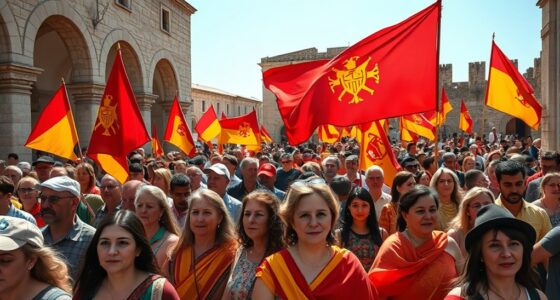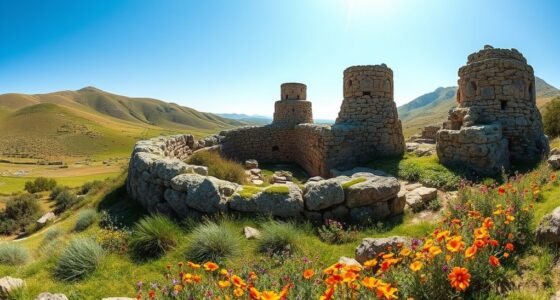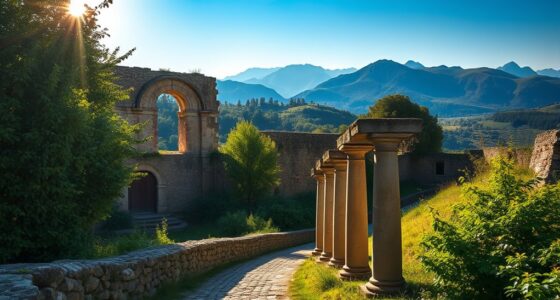Ittiri’s history dates back to prehistoric Nuragic times, where its strategic location helped develop early settlements with impressive stone structures. Through Roman, Arab, and Spanish influences, the town evolved, shaped by medieval fortifications and struggles against feudal oppression. The local community played essential roles in Sardinian revolts and movements for autonomy. If you explore further, you’ll uncover how these diverse layers of history continue to define Ittiri’s cultural identity today.
Key Takeaways
- Ittiri developed on a high plain with early settlements linked to Nuragic civilization and successive cultures like the Coracenes and Romans.
- Nuragic structures, including towers and sacred wells, highlight the region’s ancient technological and religious heritage.
- Medieval Ittiri was strategically positioned, influenced by Byzantine, Aragonese, and Spanish rule, shaping its political and social development.
- Feudal oppression and external invasions led to social resistance and revolts against landowners and colonial powers.
- Today, Ittiri’s identity is rooted in its rich archaeological, cultural, and historical legacy from ancient times through modern movements.
Early Settlements and Ancient Influences
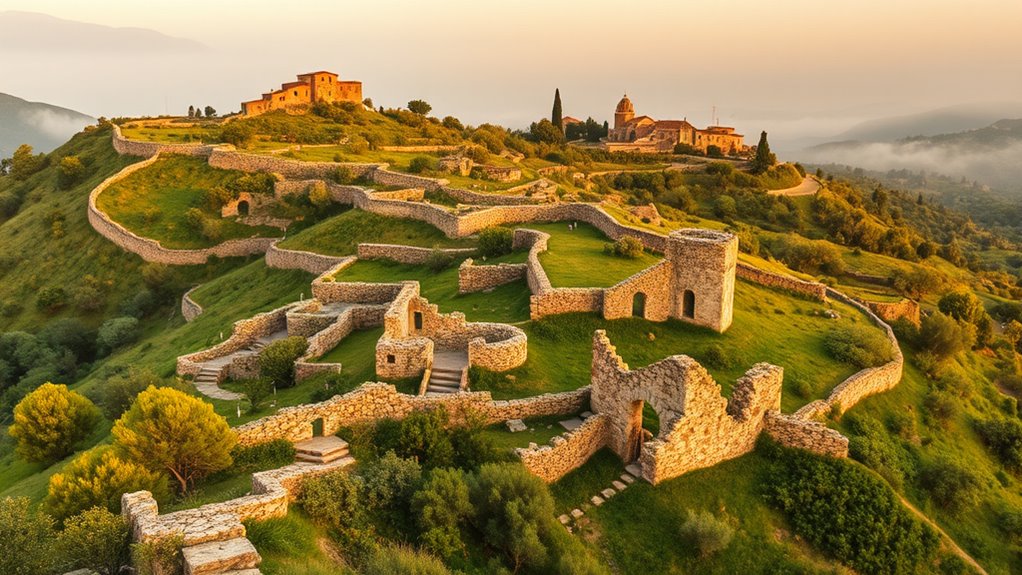
Ittiri’s early settlements developed on a high plain roughly 450 meters above sea level, where natural features like peaks, lakes, and fertile valleys provided ideal conditions for agriculture and animal husbandry. You benefit from the proximity to lakes such as Bidighinzu, Cuga, and Temo, which supported fishing and irrigation. The surrounding peaks, including Monte Torru at 620 meters, offered natural defense and vantage points. Early inhabitants, like the Ozieri culture, practiced farming, hunting, and trading, establishing a strong foundation for community life. Metalworking advances during the Chalcolithic period hint at technological progress. Over time, successive peoples—including the Coracenes, Libyans, and Romans—left their mark, shaping Ittiri’s rich cultural and archaeological heritage. These natural and cultural resources made the area a key hub for early settlement. Additionally, the development of self-watering plant pots demonstrates technological innovation, which has roots in ancient engineering concepts.
The Role of the Nuragic Civilization in Shaping Ittiri

You can see the Nuragic civilization’s influence in Ittiri through its impressive stone towers and settlements, which shaped the area’s landscape. These structures weren’t just defensive; they also reflected advanced engineering and social organization that still echoes today. Exploring this heritage reveals how Nuragic culture left a lasting mark on Ittiri’s history and identity. The archaeological remains continue to provide valuable insights into the ancient society that once thrived there.
Nuragic Architectural Heritage
The Nuragic civilization profoundly shaped Ittiri’s landscape through its distinctive architectural achievements. You’ll find around sixty nuraghi scattered across the territory, including two key examples within the archaeological park. These structures range from simple single-tower or corridor nuraghi to complex multi-towered bastions, showcasing architectural evolution. Some nuraghi feature advanced techniques like overhanging stone rows forming false vaulted chambers, reaching heights of 7 to 12 meters. Notable examples include towering central structures, originally up to 25 meters, which set a standard for Nuragic architecture. These monuments highlight a skilled use of dry-stone construction, with thick walls, spiral staircases, and defensive features like curtain walls and battlements. The landscape’s Nuragic heritage reveals a sophisticated and strategic approach to both defense and settlement planning. Construction techniques in Nuragic architecture demonstrate an advanced understanding of weight distribution and structural stability, allowing for the creation of impressive and enduring monuments. Additionally, the precise placement of nuraghi often reflects strategic location selection, emphasizing their importance in regional control and communication.
Nuragic Cultural Influence
The Nuragic civilization’s influence on Ittiri is deeply rooted in its early foundations and cultural traditions. You can see this legacy in the ongoing importance of monumental nuraghes, sacred wells, and collective tombs, which served spiritual and societal functions. The Coracenes, a Nuragic tribe, established Ittiri’s early identity, connecting it to broader Sardinian practices. Their advanced society thrived through metallurgy, agriculture, and trade, shaping local economy and social hierarchy. The table below highlights key elements of Nuragic influence:
| Aspect | Evidence | Impact on Ittiri |
|---|---|---|
| Architectural | Nuraghes, fortifications | Defining local landscape |
| Religious Practices | Sacred wells, Giants’ graves | Cultural continuity in rituals |
| Society and Economy | Metalworking, trade, agriculture | Foundation of community structure |
This cultural legacy continues to influence Ittiri’s identity today, as evidenced by the archaeological sites and local traditions that persist in the area. Additionally, Nuragic architecture remains a prominent feature of the region’s historical landscape, attracting researchers and tourists alike.
Medieval Foundations and Strategic Positioning

Ittiri’s strategic location on a high plain at approximately 450 meters above sea level gave it a natural advantage for defense and observation during the medieval period. Surrounded by peaks like Monte Torru and near lakes such as Bidighinzu, Cuga, and Temo, it had access to essential resources. Its proximity—18 km to Sassari and 28 km to Alghero—facilitated trade and military communication, strengthening its regional importance. As part of the Coros region in Logudoro, Ittiri played a key role within northern Sardinia’s geopolitical landscape. Its fertile valleys, dotted with olive groves and vineyards, supported settlement and economic activity. Constructed in the first half of the 13th century, this positioning made Ittiri a strategic hub for controlling territory, defending against invasions, and fostering early medieval growth. Additionally, its location, with access to vital trade routes, contributed to its development and regional significance.
Feudal Era Under the Ledà Family
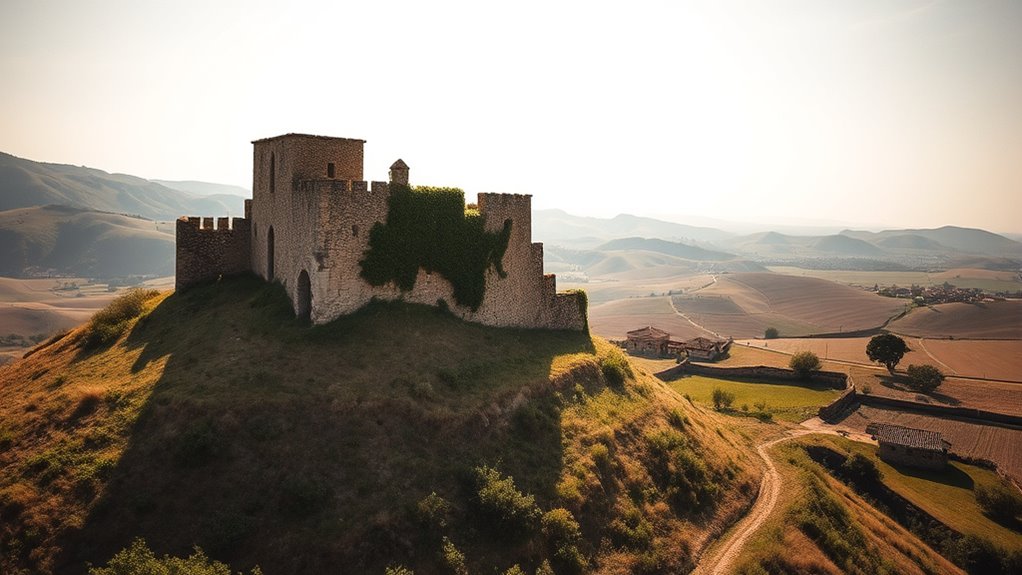
As the 17th and 18th centuries unfolded, the Ledà family, counts of Bonorva, acquired control of Ittiri’s estates, shaping its feudal landscape. They inherited the fief from the Carrillo family, who previously owned the lands of Bonorva and Torralba. During this period, disputes arose between the Ledà family and the De Miranda family over ownership rights. Don Gerolamo Vaca Ledà introduced new feudal obligations, increasing tax burdens on local communities. These heavy levies sparked protests and appeals to royal authorities like Gianbattista Lorenzo Bogino, as villagers sought relief. Poor management by the Ledà family caused production declines and economic hardship. Tensions grew, straining relations between Ittiri and Uri, and fueling unrest that reflected the broader struggles within Sardinian feudal society. The Ledà family’s control over the region also led to significant social tensions as the local population increasingly resisted their authority. This period exemplifies the complex dynamics of feudal society and the impact of landownership disputes on community stability.
Social Unrest and Resistance in the 18th Century
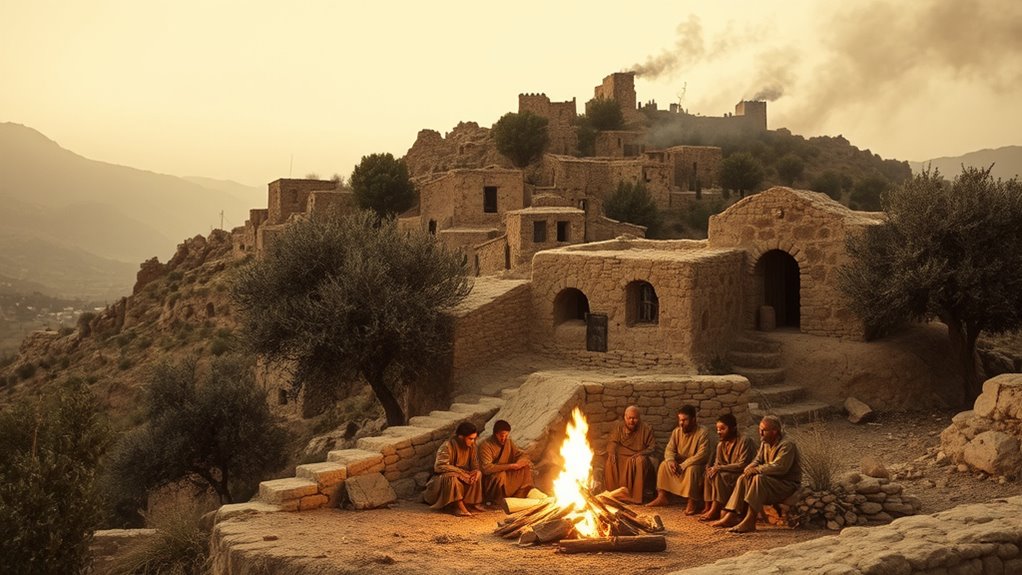
You see how the heavy taxes and unfair feudal policies sparked protests in Ittiri during the 18th century. As tensions grew, villagers organized armed revolts, attacking baronial property and demanding change. Inspired by Sardinian revolutionaries like Angioy, locals pushed back against economic hardship and oppressive rule. The unrest was fueled by widespread social unrest and resistance, which challenged the existing feudal order and called for greater autonomy.
Feudal Oppression and Protests
In the 18th century, feudal lords in Sardinia wielded extensive control over rural communities like Ittiri, imposing heavy taxes, forced labor, and land restrictions that fueled widespread discontent. You’d see peasants burdened by oppressive demands, fostering tension and resentment. Local elites, often acting as enforcers of feudal power, used harsh measures to suppress protests. Resistance emerged through various channels, including: 1. Circulating banned pamphlets and writings advocating reform, which helped spread anti-feudal ideas. 2. The involvement of priests and intellectuals, who played roles in fostering dissent and organizing resistance. 3. Reprisals, such as executions and imprisonments, which aimed to quash rebellion but often intensified unrest. These factors created a volatile environment, where social discontent simmered beneath the surface of feudal domination. The oppressive measures used by feudal authorities further exacerbated tensions and fueled ongoing unrest among the peasantry, especially as social unrest grew more widespread and difficult to contain.
Armed Revolts and Local Resistance
During the 18th century, social unrest in Ittiri and surrounding areas erupted into armed revolts as locals resisted both feudal oppression and external domination. Sardinia faced repeated invasions by Phoenicians, Romans, and Italians, fueling resistance efforts to maintain autonomy. The House of Savoy briefly granted local self-governance in the 1720s, but Italian policies soon restricted freedoms. When Italy attempted to impose private land ownership during unification, locals destroyed property boundaries as acts of defiance. The Italian government responded with military force, intensifying conflicts. In Sassari (1795), insurgents protested feudalism and sought independence, supporting Giovanni Maria Angioy’s uprising before loyalist troops suppressed the revolt. These struggles reflected deep-rooted resistance against external control and feudal oppression. Despite these efforts, the resistance movement persisted, adapting to new political challenges and continuing to fight for Sardinian self-determination.
Sardinia’s Broader Historical Context and Colonial Dominations
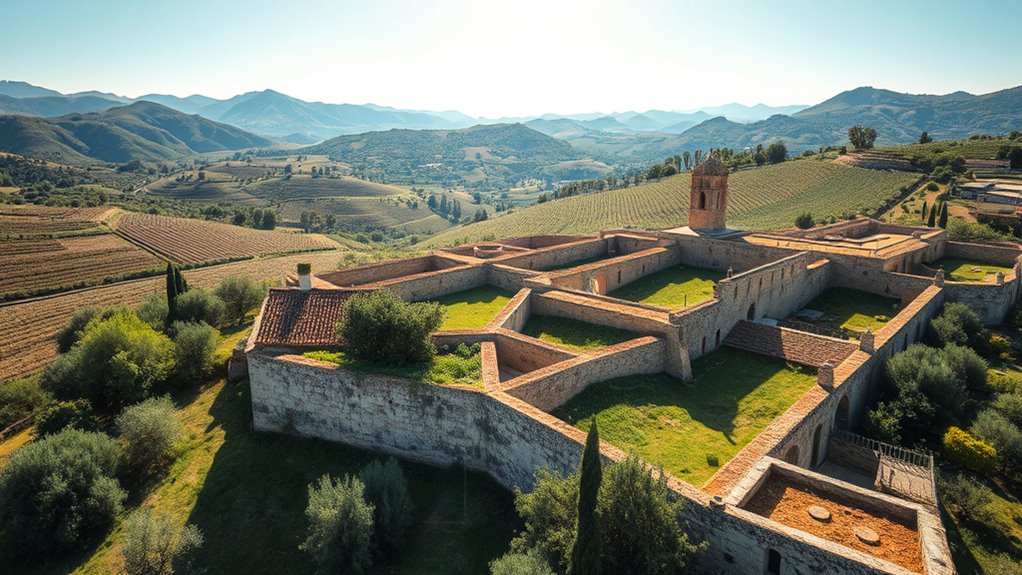
Sardinia’s strategic location in the western Mediterranean has historically made it a vital hub for trade, military operations, and colonial powers. Its position attracted Phoenicians, Romans, Arabs, and Aragonese, shaping its complex history. The Romans established Sardinia as a key province in 227 BCE, influencing language and culture, while resisting Nuraghic tribes in mountainous regions. Arab raids began in 711 CE, prompting alliances with Christian states like Pisa and Genoa, which helped defend the island and led to the emergence of four self-governing giudicati. The Crown of Aragon extended control from 1323, unifying Sardinia under Spanish rule, while maintaining local legal traditions and strategic importance for Mediterranean trade and military dominance. Additionally, Sardinia’s historical significance was further reinforced through its role as a crossroads of various civilizations, which contributed to its diverse cultural heritage.
The Rise of Self-Governance in Medieval Sardinia
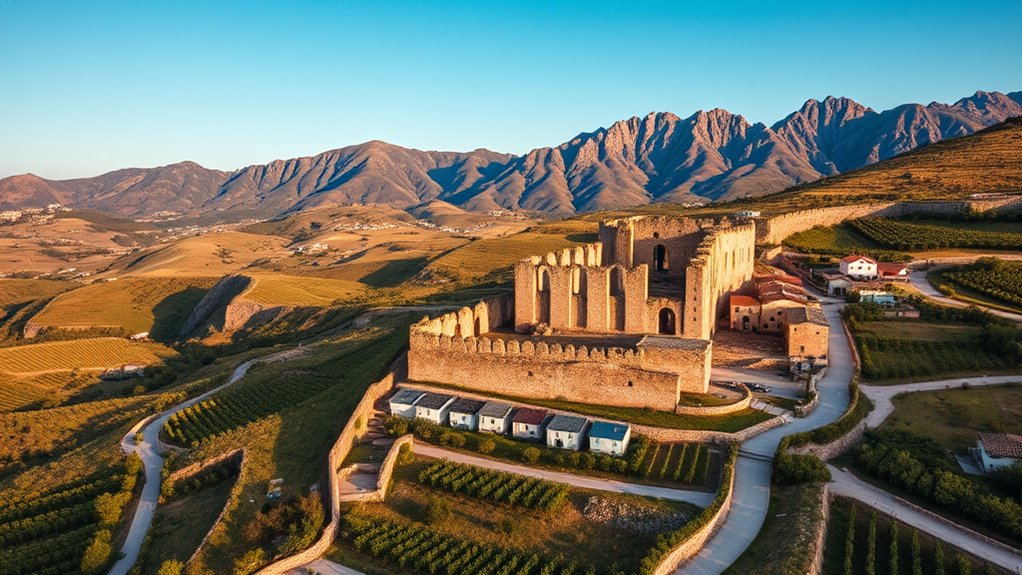
As external powers like Byzantium and Aragon shaped Sardinia’s broader history, local communities gradually began asserting their independence. You see, during the early medieval period, four autonomous kingdoms, or Judicates, emerged from Byzantine influence. The initial control of Caralis’s governor, or Iudex Provinciae, decentralized as local leaders appointed officials in coastal areas, fostering independence. By the 9th and 11th centuries, papal correspondence recognized these Judicates as distinct entities, with Cagliari, Arborea, Gallura, and Torres each developing unique laws and borders. These Judicates maintained fortified borders, legal systems, and military defenses, often participating in alliances with Italian maritime powers like Genoa and Pisa. Their political structure combined hereditary leadership with participatory assemblies, laying the foundation for Sardinia’s self-governance. Each Judicate established its own laws, further reinforcing their individual identities and political autonomy across the island.
The Impact of Spanish and Aragonese Rule

The conquest of Sardinia by the Crown of Aragon between 1323 and 1326 marked a turning point in the island’s history, transforming its political landscape and introducing Spanish governance. You’ll notice the shift through several key changes:
The Aragonese conquest of Sardinia transformed its political landscape and introduced Spanish governance.
- The establishment of the Kingdom of Sardinia under Aragonese rule, replacing indigenous Judicates with a feudal system.
- The creation of institutions like the Cortes, which allowed limited Sardinian participation in governance.
- The spread of Spanish customs and legal frameworks, influencing land ownership, social hierarchy, and cultural traditions.
This process also involved military campaigns and naval battles that solidified Aragonese control over key coastal areas. These changes centralized authority, introduced new legal and administrative structures, and integrated Sardinia into the broader Aragonese and later Spanish empire. The island’s strategic importance grew, shaping its military and political role in the Mediterranean.
Ittiri’s Role in Sardinian Revolutionary Movements

Ittiri played a significant role in Sardinian revolutionary movements, exemplifying local resistance against feudal and colonial authority. In 1796, you and neighboring Uri signed the “Act of Redemption,” aiming to reclaim lands from feudal lords, symbolizing your community’s fight for justice. Although the revolution failed and authorities repressed dissent, you responded with armed resistance, rallying with drums and rifles to challenge baronial control. Ittiri’s involvement extended into the broader Sardinian nationalist scene, especially in the 1980s, during the Sardinian Armed Movement advocating socialism and independence. This movement, linked to social conflict and banditry, reflected a deep-rooted desire for autonomy. Your town’s resistance, shaped by its ancient origins and rural landscape, highlights a persistent legacy of social struggle and regional identity. Furthermore, the local history of resistance in Ittiri is intertwined with the activities of groups like the Sardinian Autonomy Movement (MAS), which sought to merge socialist ideology with regional separatism.
Modern Administrative Development and Cultural Heritage
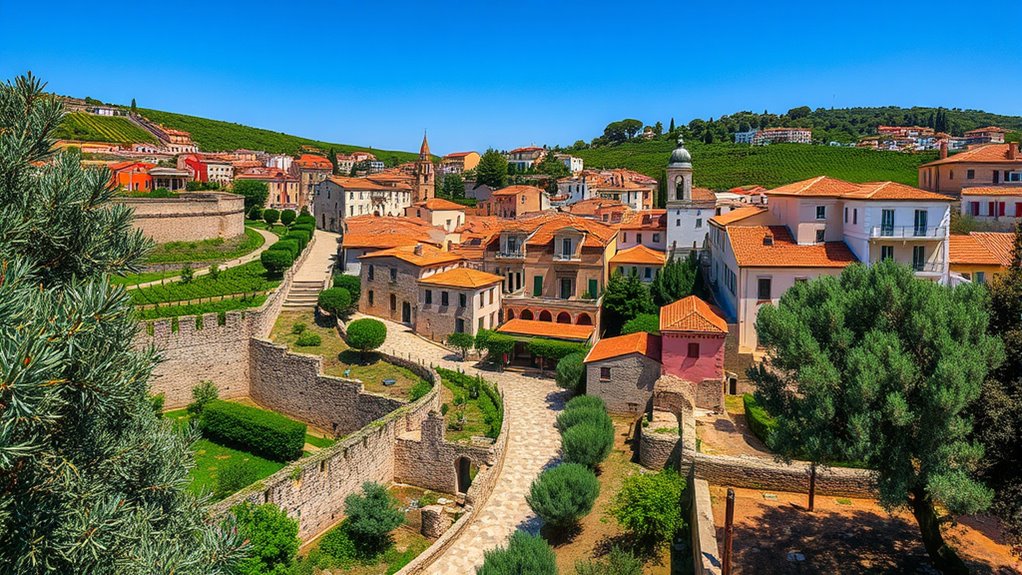
Nestled on a rugged plateau within the Province of Sassari, Ittiri has transformed from a feudal enclave into a modern municipality that reflects both regional integration and local resilience. You’ll see this evolution in its governance, moving from feudal dependencies to a contemporary local government system following Italy’s administrative reforms. The community’s identity remains strong through its cultural heritage, including Romanesque and Gothic monuments from the influence of Cistercian monks and remnants of Nuragic civilization. To deepen your understanding, consider these key aspects:
Nestled on a rugged plateau, Ittiri blends ancient heritage with modern resilience and regional integration.
- The ‘Act of Redemption’ in 1796 marked the shift toward self-rule, despite initial repression. Located in Sardinia, Italy, approximately 160 km NW of Cagliari and 15 km south of Sassari, Ittiri’s geographical position contributed to its strategic importance and regional development.
- Civic activism in the 18th century helped diminish feudal power, laying the groundwork for modern governance.
- Today, Ittiri balances tradition with regional economic integration, driven by agriculture, crafts, and cultural festivals.
Frequently Asked Questions
How Did Ittiri’s Strategic Location Influence Its Historical Development?
Your understanding of Ittiri’s strategic location is like seeing a masterful chess move. It shaped its history by offering natural defenses on a high plateau, with vantage points over key trade routes. Surrounded by peaks and fertile valleys, it became a hub for trade, settlement, and defense. Its position between coastal and inland centers allowed it to thrive, controlling movement and resources, shaping its enduring importance through the ages.
What Specific Events Marked Ittiri’s Resistance Against Feudal Authorities?
You see, Ittiri’s resistance against feudal authorities was marked by key events. On March 17, 1796, locals signed the Act of Redemption, challenging feudal control legally. That evening, around 700 villagers armed with rifles confronted feudal forces, destroyed crops, and demanded self-governance. Inspired by Sardinian revolutionary hero Angioy, you can recognize these acts of rebellion as a powerful stand against oppression and for community independence.
How Did the Nuragic Civilization Impact Ittiri’s Early Settlements?
You’ll find that Nuragic civilization deeply shaped Ittiri’s early settlements. About 20 nuraghi and numerous sacred structures highlight a complex society. You can see their influence in the monumental tombs and religious sites, which served as spiritual and social hubs. This advanced architecture reflects organized communities, political ties, and social stratification, laying a foundation for later cultural developments. Nuragic traditions persisted, leaving a lasting legacy on Ittiri’s historical and cultural landscape.
In What Ways Did Sardinian Self-Rule Manifest During Medieval Times?
During medieval times, you can see Sardinian self-rule through the independent Judicates, each led by a Judge with full legislative, military, and administrative powers. They maintained fortified borders, developed unique legal codes like the Carta de Logu, and exercised sovereignty over their territories. Despite external pressures from powers like Pisa, Genoa, and Aragon, they managed to preserve their political and military independence, shaping Sardinia’s distinct medieval identity.
What Are the Main Cultural Influences Shaping Ittiri Today?
You’ll find that Ittiri’s lively spirit is shaped by a rich tapestry of influences. Sardinian traditions, like heartfelt music and vibrant festivals, blend seamlessly with global cultures through its annual folk celebration. The town’s resilient history fosters a strong sense of pride and unity, while ancient Nuragic sites remind you of a deep-rooted connection to the past. Together, these elements create a colorful, dynamic cultural landscape worth exploring and celebrating.
Conclusion
As you explore Ittiri’s rich past, you see a land shaped by ancient civilizations and medieval struggles. From its strategic origins to modern pride, it’s a place where history’s echoes collide with vibrant culture. While the past’s hardships once fueled resistance, today, they fuel your appreciation. Ittiri’s story reminds you that through resilience, even the oldest roots can blossom into a thriving community—proof that history and hope walk hand in hand.


